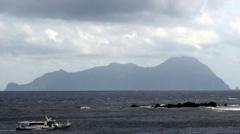For over 600 years, the Miwatari ice formation on Lake Suwa has been a revered winter phenomenon, symbolizing a divine presence; however, its recent disappearance is concerning both residents and scholars alike.
The Disappearing Ice: Lake Suwa's Mysterious Phenomenon Raises Alarms

The Disappearing Ice: Lake Suwa's Mysterious Phenomenon Raises Alarms
In central Japan, the absence of the Miwatari ice formation traditionally signifies a troubling imbalance in nature.
In the serene mountains of central Japan, the legendary Lake Suwa has long been shrouded in winter magic with a peculiar occurrence that dates back more than six centuries. Locals eagerly anticipated the winter spectacle known as the Miwatari—a sacred ice formation believed to signify the path of a wandering deity. The sight of the majestic ice ridge, reminiscent of a dragon's spine, would materialize after frigid temperatures reliably blanketed the lake in frost. The supernatural rumblings that heralded its arrival instilled both wonder and comfort, prompting communities to grace the icy surface with ritual ceremonies in reverence of the divine.
For generations, the Miwatari was not only a local curiosity but also an essential aspect of cultural identity. The residents maintained a meticulous historical record since 1443, noting details about the icy phenomenon's occurrence and the state of the lake throughout the years. This remarkable documentation reflects how the Miwatari intertwined itself with local history and collective sentiment, becoming more than just an ice formation, but a powerful emblem of seasonal transformation and spiritual connection.
However, the awe-inspiring Miwatari has experienced alarming absences in recent winters, raising eyebrows and concern among the inhabitants. Traditionally a comforting sign, the lack of this ethereal formation is being interpreted as a grim signal, indicating a disturbance in the natural order. The local Shinto priest, Kiyoshi Miyasaka, has watched the changes unfold with unease, highlighting the fragile state of the environment and the warnings it may hold for both nature and humanity.
As the memory of the Miwatari fades in face of changing climate realities, both residents and scientists are compelled to confront the implications. This beloved seasonal marker stands as an ancient warning—a call to reflect on the balance between humankind and the natural world that seems to be slipping away. While the ice may be absent, the reverberations of its significance linger, urging deeper introspection and action from all who cherish the harmony of their environment.




















